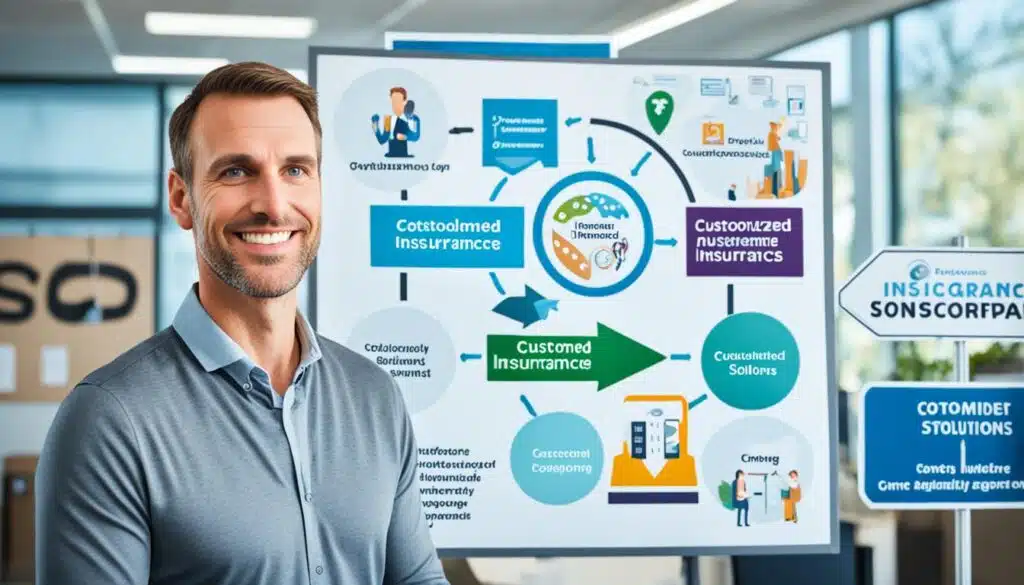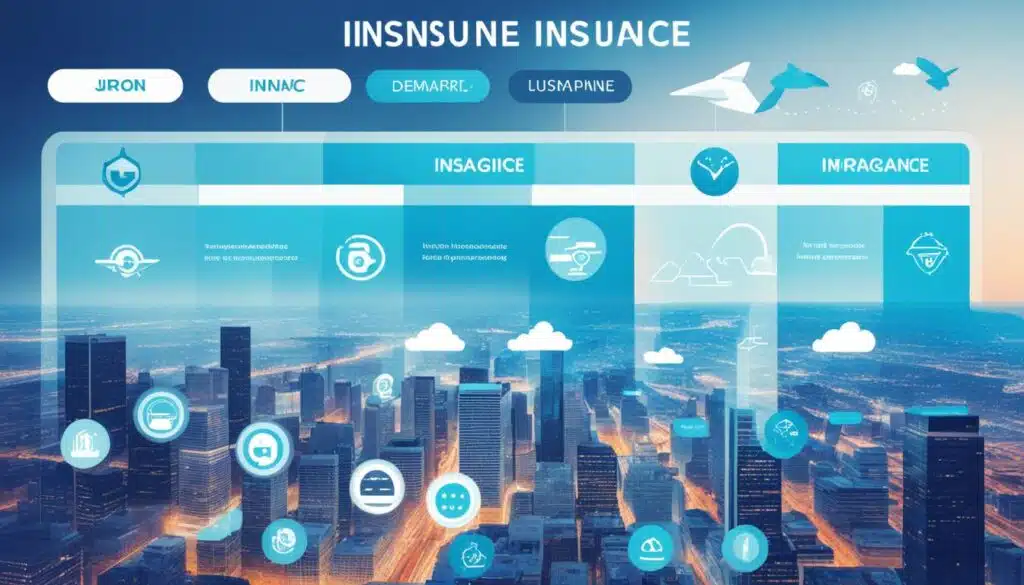Traditional Insurance From On-Demand Insurance, as the insurance industry continues to evolve, new models like on-demand insurance are disrupting the traditional landscape. Start-ups such as Trov, Slice, Cuvva, and Lings are leading the way in offering on-demand insurance products that cater to the needs of modern consumers. These insurers leverage digital technology, big data, and data analytics to provide flexible and unbundled coverage, allowing policyholders to purchase insurance when they need it, for any duration.
Key Takeaways: Traditional Insurance From On-Demand Insurance
- On-demand insurance has transformed the insurance market, driven by the rising demand for instant and personalized services.
- Traditional insurance policies offer a wide range of coverage options, while on-demand insurance provides customized solutions tailored to specific needs.
- Premiums for on-demand insurance are often more affordable due to the pay-per-use nature of coverage.
- On-demand insurance allows policyholders to purchase coverage as needed, providing flexibility and convenience.
- Advancements in technology and the increasing adoption of digital platforms have fueled the growth of on-demand insurance.
What is On-Demand Insurance?
In today’s digitally transformed insurance industry, on-demand insurance has emerged as a game-changer. This innovative insurance model caters to the evolving needs of consumers in the modern market. But what exactly is on-demand insurance?
On-demand insurance leverages the power of digital technology and individualization trends to provide flexible and personalized coverage options to policyholders. It allows insurance customers to obtain instant quotes, choose from narrow coverage options, and enjoy flexible policy durations that suit their specific needs.
With on-demand insurance, policyholders can access coverage for various activities such as traveling, driving, short-term work assignments, or sharing items. The process is simple and convenient, as policyholders can trigger coverage directly through their smartphones. Whether it’s manually activating coverage or having automated data exchange with their insurance provider, policyholders have the freedom and flexibility to obtain coverage only when they need it.
The value proposition of on-demand insurance lies in its ability to provide flexibility and unbundling capabilities. Unlike traditional insurance policies that often come with predetermined coverage terms, on-demand insurance allows customers to tailor their coverage based on their unique requirements. This customization empowers policyholders to choose the specific insurance benefits they need, ensuring they are not paying for unnecessary coverage.
In addition to its flexibility, on-demand insurance also offers digital delivery through dynamic premium rates. This means that the cost of coverage can be adjusted based on various factors such as usage, time of day, or location. The use of digital technology enables insurance providers to offer these dynamic premium rates, ensuring that policyholders only pay for the coverage they actually use.
“On-demand insurance is transforming the insurance market by providing customers with flexible and personalized coverage options.”
The rise of on-demand insurance reflects the changing dynamics of the insurance industry. As digital transformation continues to reshape various sectors, the insurance market is no exception. On-demand insurance is at the forefront of this transformation, offering customers a convenient and tailored approach to insurance coverage.
Continue reading to explore the characteristics of traditional insurance policies and understand the benefits that on-demand insurance brings to the table.
Characteristics of Traditional Insurance Policies
Traditional insurance policies offer a diverse range of coverage options that cater to a variety of needs. These policies include homeowner’s insurance, renter’s insurance, and auto insurance, among others. Policyholders can choose the coverage that best suits their individual requirements and circumstances.
When it comes to traditional insurance, policyholders are typically required to pay regular premiums for a specified period of coverage. These premiums are predetermined based on various risk factors evaluated by the insurer.
One characteristic of traditional insurance is its one-size-fits-all approach. Standardized terms and conditions are applied to these policies, ensuring consistency and clarity for policyholders. This helps to streamline the insurance process and simplify policy management.
Traditional insurance follows a one-size-fits-all approach, with standardized terms and conditions.
The premiums for traditional insurance policies are determined by several risk factors. These factors may include the policyholder’s age, location, claims history, and other relevant information. Such evaluation allows insurers to assess the level of risk associated with insuring a particular individual and adjust the premium accordingly.
Please refer to the table below for a clear comparison between traditional insurance policies and on-demand insurance offerings.
| Characteristics | Traditional Insurance Policies | On-Demand Insurance Offerings |
|---|---|---|
| Coverage Options | Wide range of options tailored to different needs | Narrow coverage options focused on specific events or short periods |
| Premiums | Regular payments for a specified period of coverage | Flexible premiums based on usage or specific time frames |
| Flexibility | One-size-fits-all approach | Customizable coverage based on individual preferences |
Note: The table above provides a concise overview of the primary differences between traditional insurance policies and on-demand insurance offerings.
Overall, traditional insurance policies provide a wide array of coverage options and follow a standardized approach, with premiums determined by risk factors. However, as the insurance industry continues to evolve, on-demand insurance is gaining momentum by offering more flexibility and tailored coverage options.
Benefits of On-Demand Insurance
On-demand insurance offers a range of benefits that set it apart from traditional insurance models. With its focus on customization and flexibility, on-demand insurance provides policyholders with tailored solutions to meet their specific needs.
One of the key benefits of on-demand insurance is the ability to customize coverage. Policyholders can choose the exact insurance options they require, ensuring that they are not paying for unnecessary coverage. This customized approach allows individuals to create insurance solutions that align with their unique circumstances and preferences.
Another advantage of on-demand insurance is the affordability of premiums. Unlike traditional insurance, where regular premium payments may be required, on-demand insurance offers a pay-per-use model. Policyholders only pay for the coverage they actually use, resulting in more affordable premiums. This flexibility in payment structure makes insurance more accessible to a wider range of individuals.
Additionally, on-demand insurance provides instant coverage, allowing customers to obtain insurance quickly and easily. With traditional insurance, it may take weeks or even months to secure coverage. On-demand insurance eliminates this time-consuming process by providing immediate coverage. This instant access to insurance ensures that individuals are protected whenever and wherever they need it.
Furthermore, on-demand insurance offers as-needed coverage, allowing policyholders to purchase insurance for short periods when they require it. This flexibility is particularly beneficial for individuals who engage in temporary activities or have sporadic insurance needs. Whether it’s for a weekend trip, a one-day event, or a short-term project, policyholders can obtain coverage for the duration they need it, without long-term commitments.
The customer experience is also greatly enhanced with on-demand insurance. The convenience of being able to purchase coverage instantly, customize options, and pay for only what is needed creates a seamless and user-friendly experience. Through digital platforms and user-friendly apps, on-demand insurance providers prioritize customer satisfaction and ease of use.
Overall, on-demand insurance revolutionizes the insurance industry by offering customized solutions, affordable premiums, instant coverage, as-needed coverage, and an improved customer experience. As more individuals seek personalized and flexible insurance options, the popularity of on-demand insurance is expected to continue growing.
The Growing Trend of On-Demand Insurance
On-demand insurance is experiencing a growing trend in the insurance market, fueled by the emergence of innovative insurtech companies. These on-demand insurers are leveraging digital platforms to revolutionize insurance offerings and cater to the evolving needs of consumers.
The increasing adoption of smartphones and digital technology has significantly contributed to the expansion of on-demand insurance in recent years. Customers now have easy access to digital platforms that provide personalized and flexible insurance solutions.
“The rise of on-demand insurance has transformed the way insurance is perceived and purchased. Insurtech companies have paved the way for a new era of insurance that focuses on convenience, flexibility, and customer-centricity.” – [Quote from industry expert]
Through the integration of digital platforms, on-demand insurance providers offer an array of innovative and tailored insurance products and services. This trend addresses the demand for instant coverage, customized policy options, and more accessible insurance offerings.
In an increasingly fast-paced world, where customers seek quick and convenient solutions, on-demand insurance fills a crucial gap in the market. The ability to purchase insurance on-demand, when needed, has resonated with modern consumers who desire flexibility and control over their insurance coverage.
Rising Popularity and Future Prospects
The future of on-demand insurance looks promising, with market projections indicating substantial growth. As technology continues to advance and consumers increasingly embrace digital solutions, the on-demand insurance market is expected to expand further.
The ongoing development of insurtech and digital platforms will fuel the growth of on-demand insurance offerings. This trend will be further propelled as insurance companies embrace digital transformation and adapt their business models to cater to changing customer preferences.
| Key Factors Driving the Growth of On-Demand Insurance | Benefits for Consumers |
|---|---|
| Increasing demand for personalized and flexible insurance solutions | Ability to obtain coverage on-demand, tailored to specific needs |
| Rapid advancements in digital technology and data analytics | Convenience and accessibility through digital platforms |
| Shift in consumer behavior towards instant and usage-based services | Cost-effectiveness due to pay-per-use insurance |
| Emergence of innovative insurtech companies | Enhanced customer experience through seamless digital transactions |
The growing trend of on-demand insurance signifies a paradigm shift in the insurance industry. Traditional insurers are recognizing the need to adapt and embrace technological innovation to remain competitive in a dynamic market landscape.
As consumers continue to seek more personalized and flexible insurance solutions, the on-demand insurance market will continue to grow and challenge traditional insurance models. Insurance companies that leverage digital platforms and innovative insurance offerings will be at the forefront of this evolving landscape.
Comparison to Traditional Insurance Policies
On-demand insurance offerings differ significantly from traditional insurance policies in terms of coverage options and purchasing flexibility. Unlike traditional insurance, which often involves long-term commitments and standardized coverage, on-demand insurance allows customers to purchase insurance for specific events or short periods based on their individual needs.
One of the key advantages of on-demand insurance is the ability for policyholders to customize their coverage. Instead of being limited to predefined packages, customers have the freedom to choose the specific insurance benefits they require, tailoring their coverage to their unique circumstances. This customization feature provides a more personalized approach and ensures that policyholders only pay for the coverage they need.
Another significant difference between traditional insurance and on-demand insurance is the purchasing experience. On-demand insurance providers often leverage digital platforms, making it convenient and seamless for customers to purchase insurance. Through user-friendly interfaces and intuitive online processes, policyholders can quickly and easily select the coverage options that best suit their requirements. This digital approach eliminates the need for extensive paperwork and lengthy approval processes, offering a hassle-free insurance purchasing experience.
Furthermore, on-demand insurance allows customers to purchase coverage for specific events or periods, offering greater flexibility compared to traditional insurance. This flexibility is particularly beneficial for individuals who engage in activities with variable risk exposures or have short-term insurance needs. By offering coverage on-demand, insurance providers empower policyholders to obtain insurance precisely when they need it, ensuring adequacy and relevance of coverage.
Ultimately, on-demand insurance transforms the traditional insurance landscape by providing more customization, flexibility, and convenience. Whether it is purchasing insurance for a single event or tailoring coverage options to specific needs, on-demand insurance offerings cater to the evolving demands of modern policyholders, ensuring a more responsive and customer-centric approach to insurance.
Highlights:
- Difference in coverage options and purchasing flexibility
- Customized insurance solutions for policyholders
- User-friendly digital platforms for seamless purchasing
- Flexibility in purchasing coverage for specific events or periods
The Role of Technology in On-Demand Insurance
Technology plays a crucial role in enabling the on-demand insurance model. Insurtech companies leverage digitalization and advancements in technology to provide innovative on-demand insurance services. In particular, the Internet of Things (IoT) and telematics have revolutionized the insurance industry, enabling real-time data collection and analysis for more accurate pricing and coverage options.
With the help of IoT devices, such as connected cars, smart homes, and wearable devices, insurers can gather valuable data on the behavior and activities of policyholders. This data is then utilized to assess risks, determine premium rates, and provide customized insurance solutions.
“The integration of IoT and telematics has transformed the way insurers operate in the on-demand insurance market,” says John Davis, CEO of InsureNow, an insurtech company specializing in on-demand coverage. “By leveraging these technologies, we can offer more personalized and tailored insurance options to our customers.”
Telematics technology, which combines telecommunications and informatics, allows insurers to collect and analyze real-time data related to driving behavior. By monitoring factors such as speed, acceleration, and braking patterns, insurers can offer usage-based insurance products that align with the specific needs and driving habits of individual policyholders.
Digitalization has also streamlined the application and claims processes in on-demand insurance. Through user-friendly mobile apps and online platforms, customers can effortlessly purchase and manage their on-demand insurance coverage. The elimination of paperwork and manual processes makes it fast, convenient, and hassle-free for policyholders to obtain the coverage they need.
The seamless integration of technology into on-demand insurance offerings enhances the overall customer experience, providing a convenient and efficient way to access insurance solutions whenever and wherever needed. As technology continues to evolve, the on-demand insurance market is likely to witness further advancements and innovations, delivering even more value to policyholders.
| Advancements in Technology | Key Benefits for On-Demand Insurance |
|---|---|
| Internet of Things (IoT) | Real-time data collection for accurate pricing and coverage options |
| Telematics | Usage-based insurance tailored to individual policyholders |
| Digitalization | Seamless application and claims processes for a convenient customer experience |
The Future of Technology in On-Demand Insurance
As technology continues to advance, its role in on-demand insurance is only expected to grow. The Internet of Things will continue to expand, with more connected devices providing insurers with a wealth of data to better understand and assess risks.
Furthermore, the integration of artificial intelligence and machine learning algorithms will enhance insurers’ ability to analyze data, predict claims, and personalize coverage options. This will result in more accurate pricing, improved risk management, and increased customer satisfaction.
Overall, technology will remain a driving force behind the evolution of on-demand insurance, enabling insurers to deliver tailored and flexible coverage options that cater to the changing needs of policyholders.
Risk Selection in On-Demand Insurance
Risk selection is a critical factor in the realm of on-demand insurance. It involves evaluating and managing the risks associated with providing coverage to customers. Insurers must be mindful of the concept of asymmetric information—that is, the unequal access to information between insurers and customers—in the on-demand insurance market. This information asymmetry can lead to a phenomenon known as adverse selection, where individuals with higher risk levels are more likely to purchase insurance.
Adverse selection poses challenges for insurers as it can result in imbalances within risk pools. When a disproportionate number of higher-risk individuals purchase insurance, it can impact the profitability of insurers and disrupt the sustainability of their on-demand insurance offerings. To mitigate adverse selection, insurers need to carefully evaluate the risks associated with insuring different customer segments and adjust their underwriting processes and coverage offerings accordingly.
Moreover, the flexible nature of on-demand insurance may introduce moral hazard. Moral hazard refers to the behavioral changes that occur when individuals are protected against certain risks. In the context of on-demand insurance, the immediate access and flexibility of coverage may influence customers to engage in riskier behavior or overutilize insurance services. Insurers must strike a balance between providing convenient and accessible coverage while managing the potential moral hazard that could arise.
Overall, effective risk selection is crucial for on-demand insurers to ensure the sustainability and profitability of their offerings. By carefully assessing and managing the risks associated with adverse selection and moral hazard, insurers can establish a well-balanced risk portfolio, preserve their financial stability, and provide reliable coverage for their customers.
The Future of On-Demand Insurance
The future of on-demand insurance holds significant potential for the insurance industry. As market trends continue to shift, the role of on-demand insurance is expected to play a key part in shaping the industry’s evolution. Business model innovation will be crucial for insurers to remain competitive and meet the changing demands of customers. To stay relevant in a rapidly changing market landscape, insurers must adapt their existing business models and integrate on-demand insurance offerings.
In response to the increasing customer demand for personalized and flexible insurance solutions, on-demand insurance is likely to continue growing in popularity and market share. Advancements in technology, such as digital platforms and data analytics, will further drive this trend. Insurers that leverage technology and embrace business model innovation will be well-positioned to capitalize on the opportunities presented by the on-demand insurance market.
By providing customized and flexible coverage options, on-demand insurance addresses the evolving needs of modern consumers. With on-demand insurance, policyholders can obtain insurance as and when they need it, catering to their specific circumstances. This personalized approach enhances the overall customer experience and offers a level of convenience that traditional insurance models struggle to match.
“The future of on-demand insurance lies in its ability to reshape the insurance industry through innovation and adaptation to market trends.” – Insurance Industry Expert
As on-demand insurance grows in popularity, it will continue to disrupt the insurance industry and challenge traditional insurers. To remain competitive, traditional insurers must embrace technological advancements and integrate on-demand insurance features into their existing business models. This will enable them to offer more flexible coverage options and enhance the overall customer experience.
In conclusion, the future role of on-demand insurance in the insurance industry is promising. As market trends continue to evolve, insurers that embrace business model innovation and leverage advancements in technology will be well-positioned to thrive in the changing landscape. The increasing demand for personalized and flexible insurance solutions, coupled with the convenience and accessibility of on-demand insurance, suggests a bright future for this innovative insurance model.
The Impact on Traditional Insurers
The rise of on-demand insurance companies is having a significant impact on the traditional insurance industry, presenting both challenges and opportunities. Traditional insurers now face increased competition from on-demand insurance providers, who offer more flexible and customized insurance solutions to meet the changing needs of modern consumers. This new wave of competition is driving traditional insurers to reevaluate their business models and adapt to stay relevant in an evolving insurance landscape.
One of the key challenges for traditional insurers is the need to incorporate elements of on-demand insurance into their existing operations. This includes embracing digital platforms and technologies that enable flexible coverage options and streamline the insurance purchasing process. By leveraging technology and innovation, traditional insurers can enhance their customer experience and effectively compete with on-demand insurance companies.
Embracing digital transformation is crucial for traditional insurers to remain competitive in the insurance industry. As on-demand insurance continues to gain traction, traditional insurers must adapt to the changing demands of customers and provide more personalized and customer-centric insurance solutions. This not only attracts new customers but also helps retain existing policyholders in an increasingly competitive market.
“The rise of on-demand insurance companies has disrupted the traditional insurance industry, forcing traditional insurers to rethink their business models and incorporate elements of flexibility and customization.”
Moreover, traditional insurers can capitalize on the growing popularity of on-demand insurance by partnering with or investing in on-demand insurance companies. This strategic collaboration allows traditional insurers to tap into the innovation and agility of on-demand insurance providers, leveraging their expertise to enhance their own offerings and expand their market share.
In summary, the rise of on-demand insurance companies presents both challenges and opportunities for traditional insurers. To remain competitive, traditional insurers need to embrace digital transformation, adapt their business models, and provide more flexible and customized insurance solutions. By doing so, traditional insurers can thrive in an evolving insurance industry and meet the changing needs of modern consumers.
Regulation and Legal Considerations
The on-demand insurance market operates within a framework of regulation and legal considerations. Each state may have its own set of insurance regulations, and it is crucial for on-demand insurance companies to comply with these regulations to ensure the legality of their offerings.
Adhering to state insurance regulations helps protect policyholders, ensuring that they receive fair treatment and appropriate coverage. It also contributes to market stability and prevents fraud or unscrupulous practices within the on-demand insurance industry.
Privacy policies and legal terms are essential components of on-demand insurance. Privacy policies outline how personal information is collected, stored, and used, ensuring transparency and safeguarding individuals’ privacy rights. Legal terms, on the other hand, lay out the contractual obligations and rights of both policyholders and insurance providers.
As the on-demand insurance market continues to evolve and expand, regulators and policymakers play a vital role in addressing potential gaps in existing regulations. Their efforts aim to enhance consumer protection, foster healthy competition, and create an environment conducive to innovation and market growth.
State Insurance Regulations
State insurance regulations form the backbone of the on-demand insurance industry. Each state has its own insurance laws and regulatory bodies, such as state insurance departments or commissions, responsible for overseeing insurance activities within their jurisdictions.
These regulations ensure that on-demand insurance companies adhere to certain standards and practices. They cover various aspects, such as licensing requirements, financial stability, consumer protection, and claims handling procedures. By complying with these regulations, on-demand insurance providers demonstrate their commitment to operating ethically and transparently.
Privacy Policies and Legal Terms
Privacy policies and legal terms are critical for on-demand insurance companies and policyholders alike. Privacy policies outline how personal information is collected, used, stored, and shared by the insurance providers. These policies help build trust by ensuring transparency and protecting policyholders’ privacy rights.
Legal terms, often embedded in policy documentation, outline the contractual relationship between the insurance provider and the policyholder. They define the rights and obligations of both parties, including coverage details, premium payment terms, claims procedures, and dispute resolution mechanisms.
“Privacy policies and legal terms are essential components of on-demand insurance, safeguarding policyholders’ privacy rights and establishing the contractual framework for the insurance coverage.”
Addressing Regulatory Gaps
As the on-demand insurance market evolves, regulators and policymakers must address potential gaps in existing regulations. This ongoing process ensures the industry’s continued growth and protects the interests of both policyholders and insurers.
Also Read:- National General Insurance: Coverage & Benefits
Regulatory bodies must stay informed about emerging technologies and business models in the on-demand insurance space. This enables them to adapt and develop regulations that foster innovation while mitigating risks. Collaboration between regulators, policymakers, and industry stakeholders is crucial to strike the right balance between consumer protection and supporting market growth.
| Regulation Considerations | Legal Considerations |
|---|---|
| Compliance with state insurance regulations | Privacy policies |
| Market stability | Legal terms |
| Consumer protection | |
Conclusion
In conclusion, on-demand insurance offers a compelling alternative to traditional insurance models. With its flexible and personalized approach, on-demand insurance caters to the evolving needs of modern consumers. By leveraging digital technology and data analytics, on-demand insurance providers are able to deliver seamless and on-demand coverage, making insurance more accessible and convenient than ever before.
While the on-demand insurance market is currently relatively small in terms of market share, its growth potential is significant. Insurance providers, both traditional and on-demand, must recognize the shifting landscape of the insurance industry and adapt their business models accordingly. Embracing technological innovation is crucial for traditional insurers to compete with on-demand insurance providers and meet the changing demands of customers.
The ongoing evolution of the insurance market will continue to shape the industry’s future. As on-demand insurance gains traction and more consumers opt for personalized and flexible coverage, the insurance market is expected to become more dynamic and diverse. Traditional insurers must not only keep up with these changes but also capitalize on the opportunities presented by on-demand insurance in order to stay relevant and competitive in the industry.
FAQs
A: Traditional insurance typically involves long-term policies and fixed coverage, whereas on-demand insurance offers coverage for short periods and can be purchased as needed.
Q: How can insurtech companies benefit from the on-demand insurance trend?
A: Insurtech companies can capitalize on the on-demand insurance trend by providing more flexible and convenient insurance options to consumers.
Q: What are some examples of situations where on-demand insurance may be more suitable than traditional insurance?
A: On-demand insurance may be more suitable for needs such as temporary travel, short-term rentals like Airbnb, or one-time events that require insurance coverage.
Q: Are there specific types of insurance commonly offered in an on-demand format?
A: Yes, on-demand insurance is often offered for needs such as event insurance, travel insurance, and on-demand health insurance.
Q: How is on-demand insurance pricing compared to traditional insurance?
A: On-demand insurance is often more affordable than traditional insurance, as it allows individuals to only buy insurance when they need it, saving costs in the long run.
Q: Can on-demand insurance cater to businesses as well as individuals?
A: Yes, on-demand insurance can cater to both individuals and businesses, providing more flexibility and tailored coverage options for various needs.
Q: What role does technology play in the growth of on-demand insurance?
A: Technology, such as smartphone applications and online platforms, has facilitated the rise of on-demand insurance by making it easier for consumers to purchase and manage their insurance policies.










